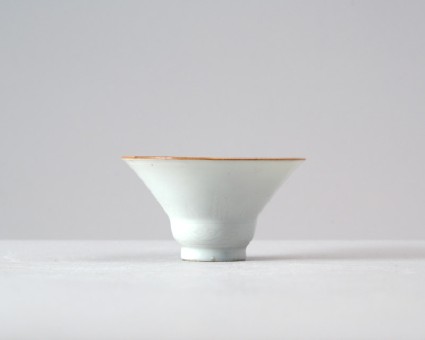The Barlow Collection
A select catalogue of the Barlow collection of Chinese Ceramics, Bronzes and Jades by the University of Sussex (published Sussex, 2006).

Publications online: 456 objects
White ware bowl with floral decoration
- loan
-
Literature notes
The bowl is incised on the base with the mark Xuanhe. Xuanhe (1119–1125) is the name of the last reign period of the Song dynasty Emperor Huizong (r. 1101–1125), a renowned art lover and one of the most famous rulers of antiquity. The inscription here evokes an idealized past in general, rather than referring to a particular model of that period. Bowls of this type were not made at that time.
The small bowl has widely flaring sides with a bulbous section above the straight foot. The flaring part is engraved with larger and smaller upright leaves, widely spaced, and the bulbous part with a classic-scroll border. The bowl is monochrome white, with a colourless glaze, but the rim is covered with a yellowish-brown dressing. -
Details
- Associated place
-
Asia › China › Jiangxi province › Jingdezhen › Jingdezhen kilns (place of creation)
- Associated people
-
Song Huizong (Emperor) (1080 - 1135) (named on object)
- Material and technique
- porcelain, thrown, with incised decoration under a bluish-white (qingbai ware) glaze; rim, painted brown
- Dimensions
-
4.6 cm (height)
8.2 cm (diameter)
- Material index
- Technique index
- Object type index
- No. of items
- 1
- Credit line
- Lent by the Sir Alan Barlow Collection Trust.
- Accession no.
- LI1301.127
-
Further reading
University of Sussex, and Arts and Humanities Research Council, The Barlow Collection, supervised by Regina Krahl, Maurice Howard, and Aiden Leeves (Sussex: University of Sussex, 2006), no. C101
Glossary (2)
glaze, porcelain
-
glaze
Vitreous coating applied to the surface of a ceramic to make it impermeable or for decorative effect.
-
porcelain
Ceramic material composed of kaolin, quartz, and feldspar which is fired to a temperature of c.1350-1400⁰c. The resulting ceramic is vitreous, translucent, and white in colour.
Location
-
- currently in research collection
Objects are sometimes moved to a different location. Our object location data is usually updated on a monthly basis. Contact the Jameel Study Centre if you are planning to visit the museum to see a particular object on display, or would like to arrange an appointment to see an object in our reserve collections.
Publications online
-

The Barlow Collection
The bowl is incised on the base with the mark Xuanhe. Xuanhe (1119–1125) is the name of the last reign period of the Song dynasty Emperor Huizong (r. 1101–1125), a renowned art lover and one of the most famous rulers of antiquity. The inscription here evokes an idealized past in general, rather than referring to a particular model of that period. Bowls of this type were not made at that time.
The small bowl has widely flaring sides with a bulbous section above the straight foot. The flaring part is engraved with larger and smaller upright leaves, widely spaced, and the bulbous part with a classic-scroll border. The bowl is monochrome white, with a colourless glaze, but the rim is covered with a yellowish-brown dressing.
Notice
Object information may not accurately reflect the actual contents of the original publication, since our online objects contain current information held in our collections database. Click on 'buy this publication' to purchase printed versions of our online publications, where available, or contact the Jameel Study Centre to arrange access to books on our collections that are now out of print.
© 2013 University of Oxford - Ashmolean Museum




